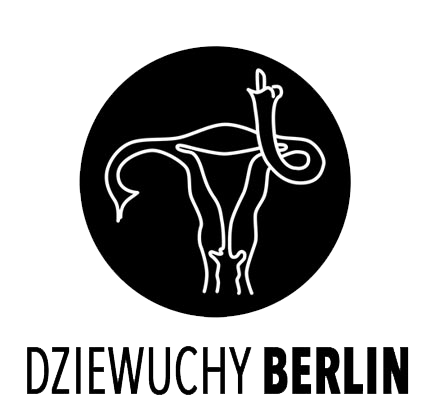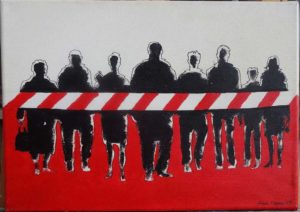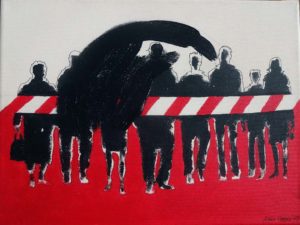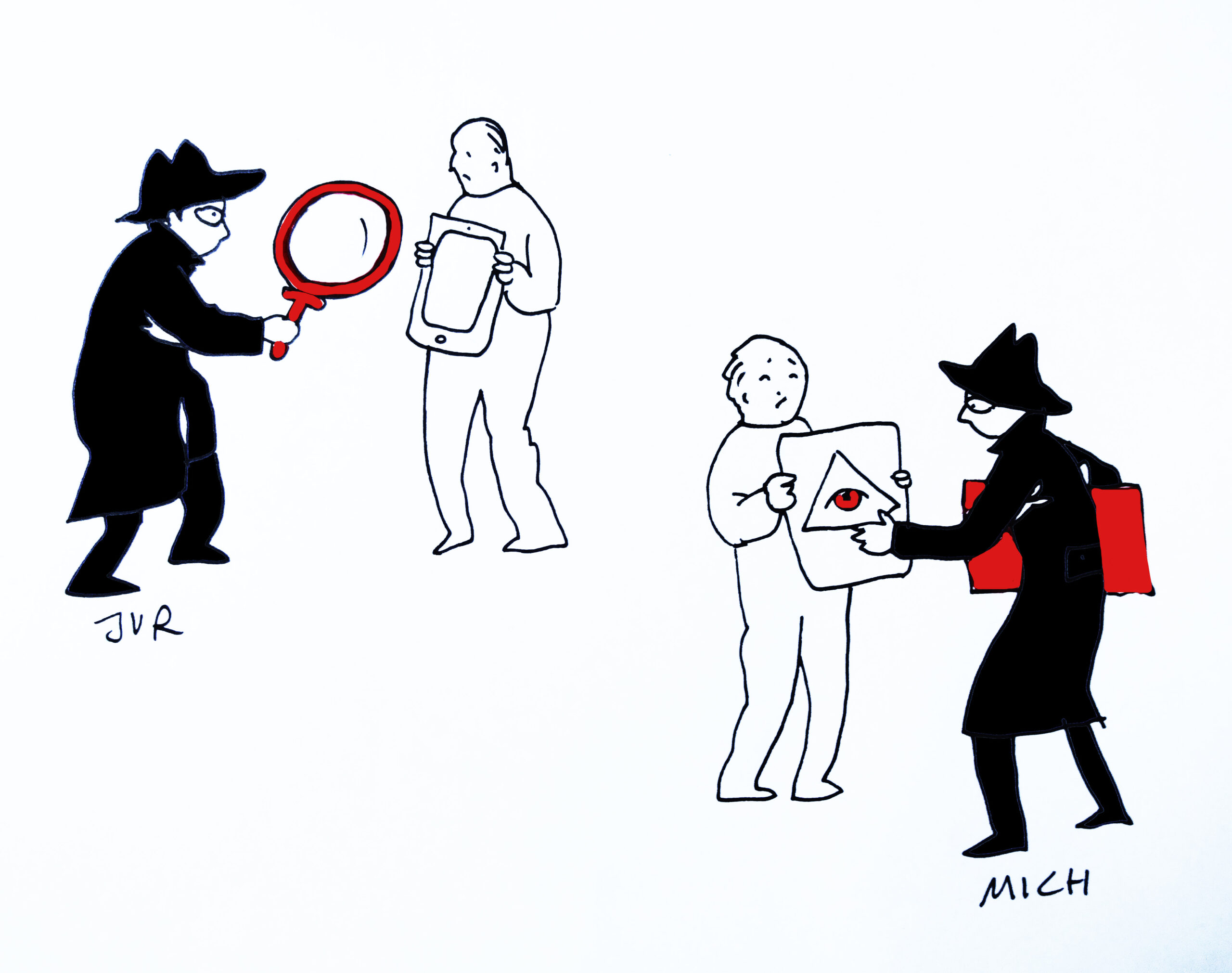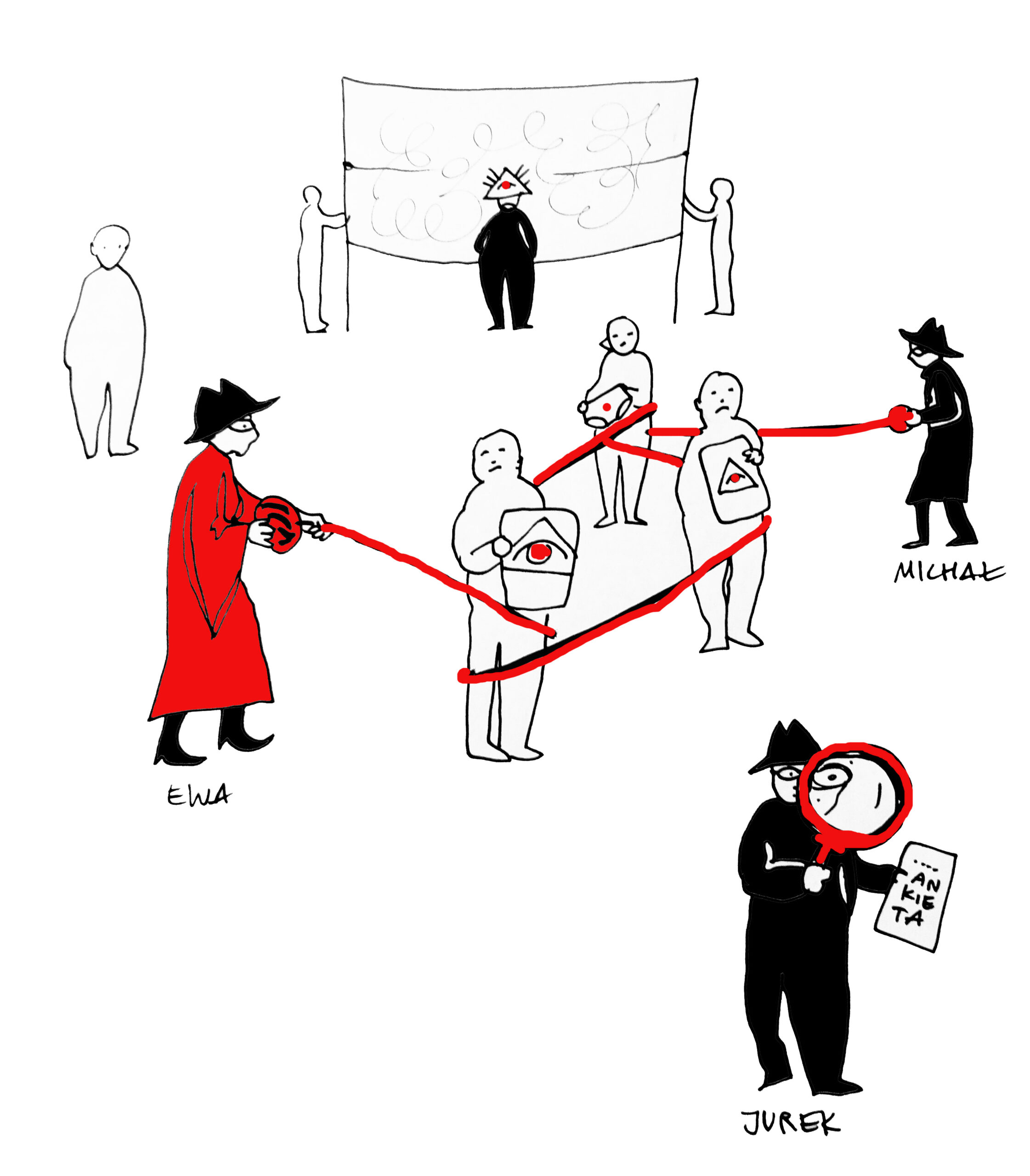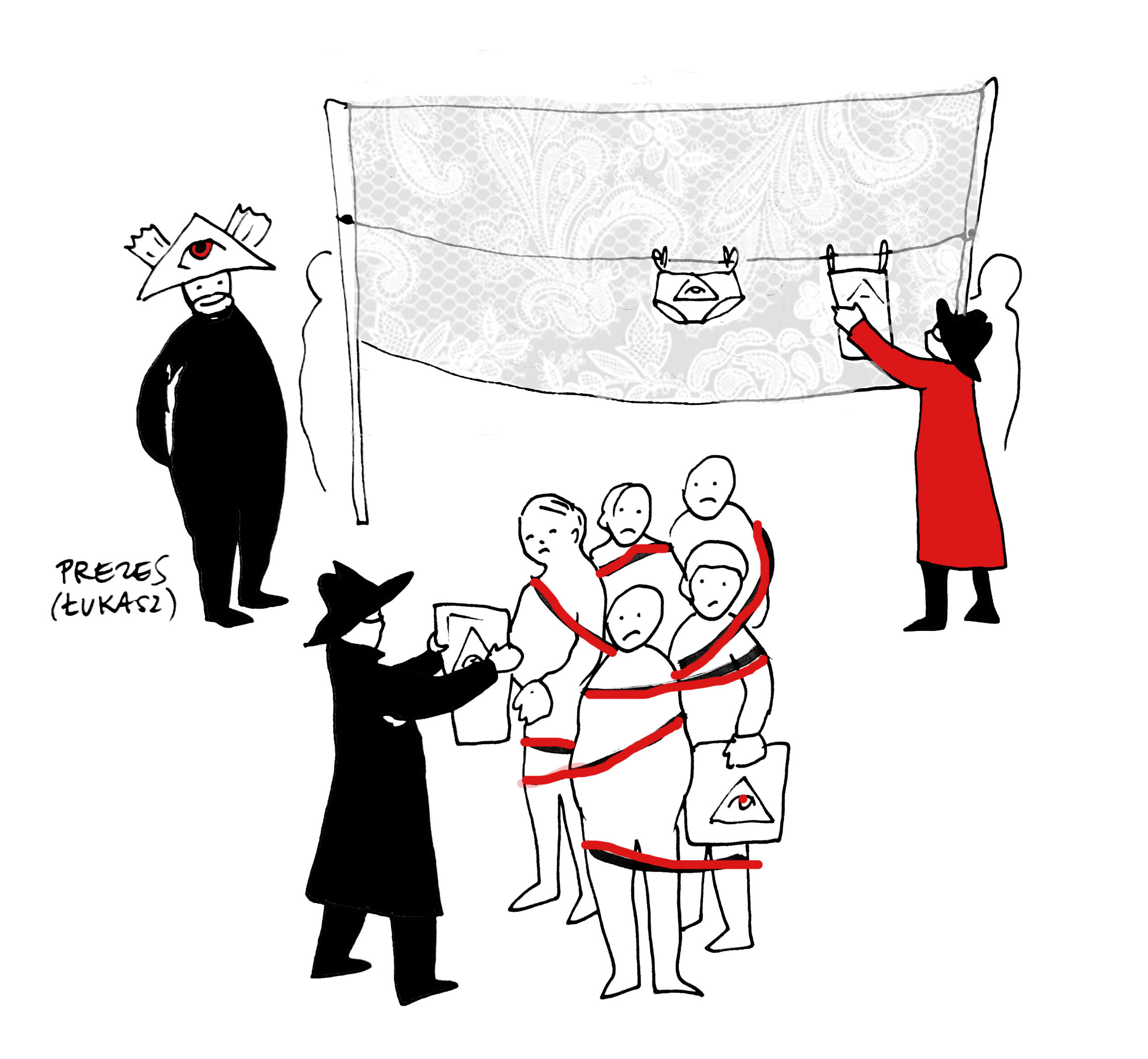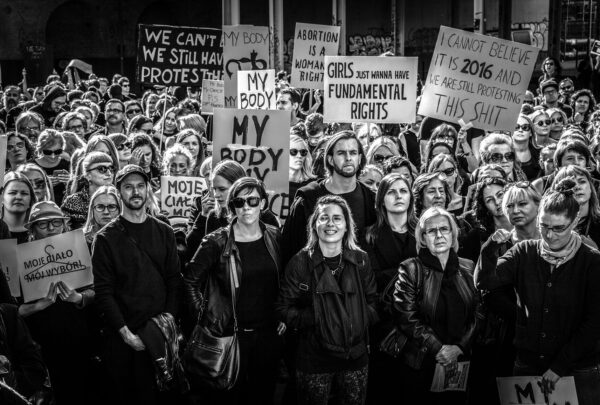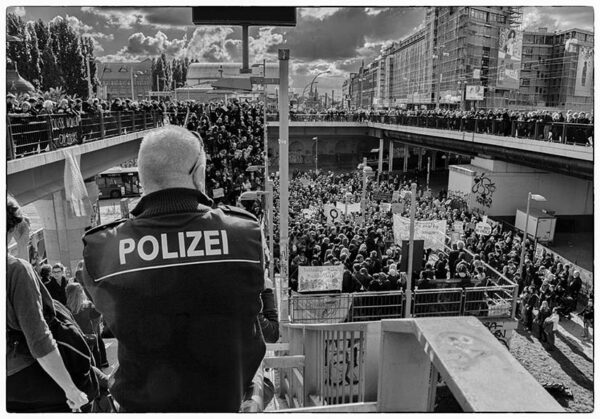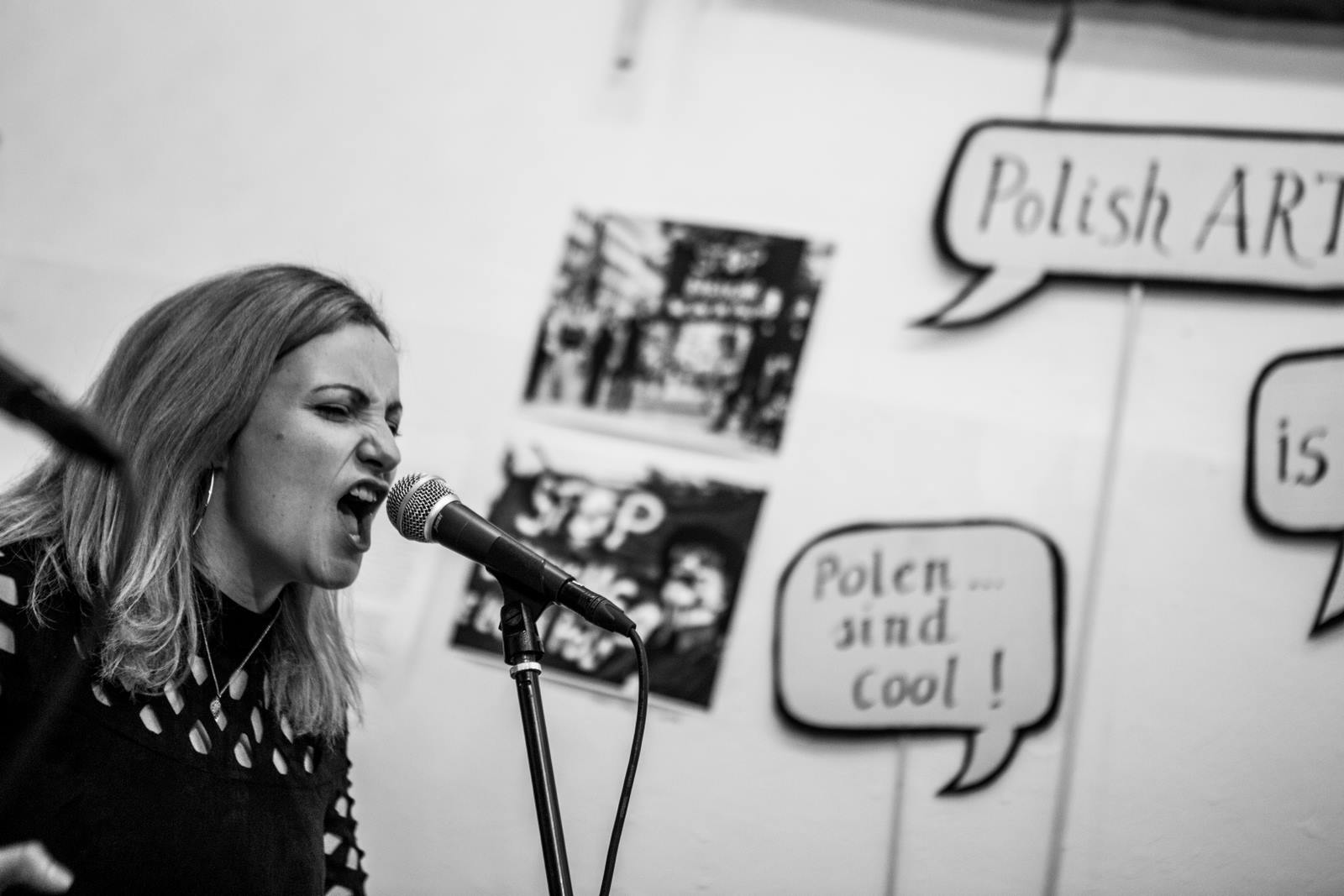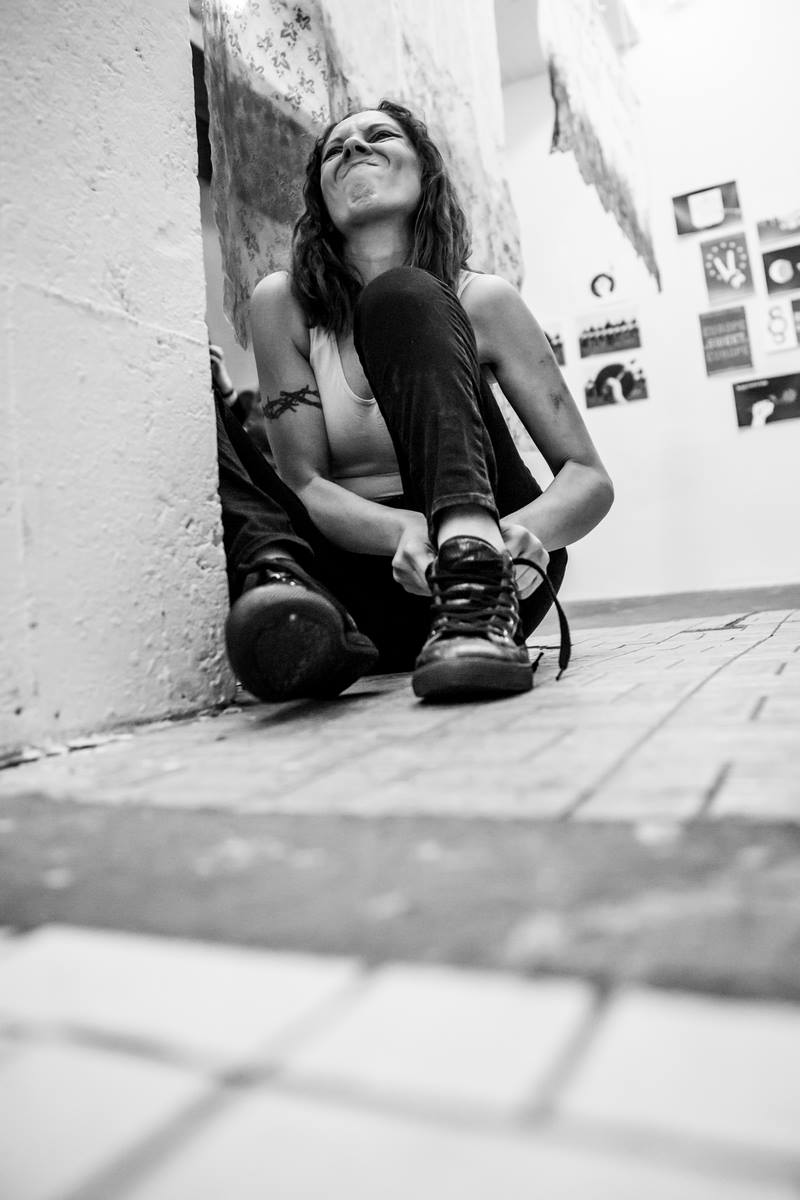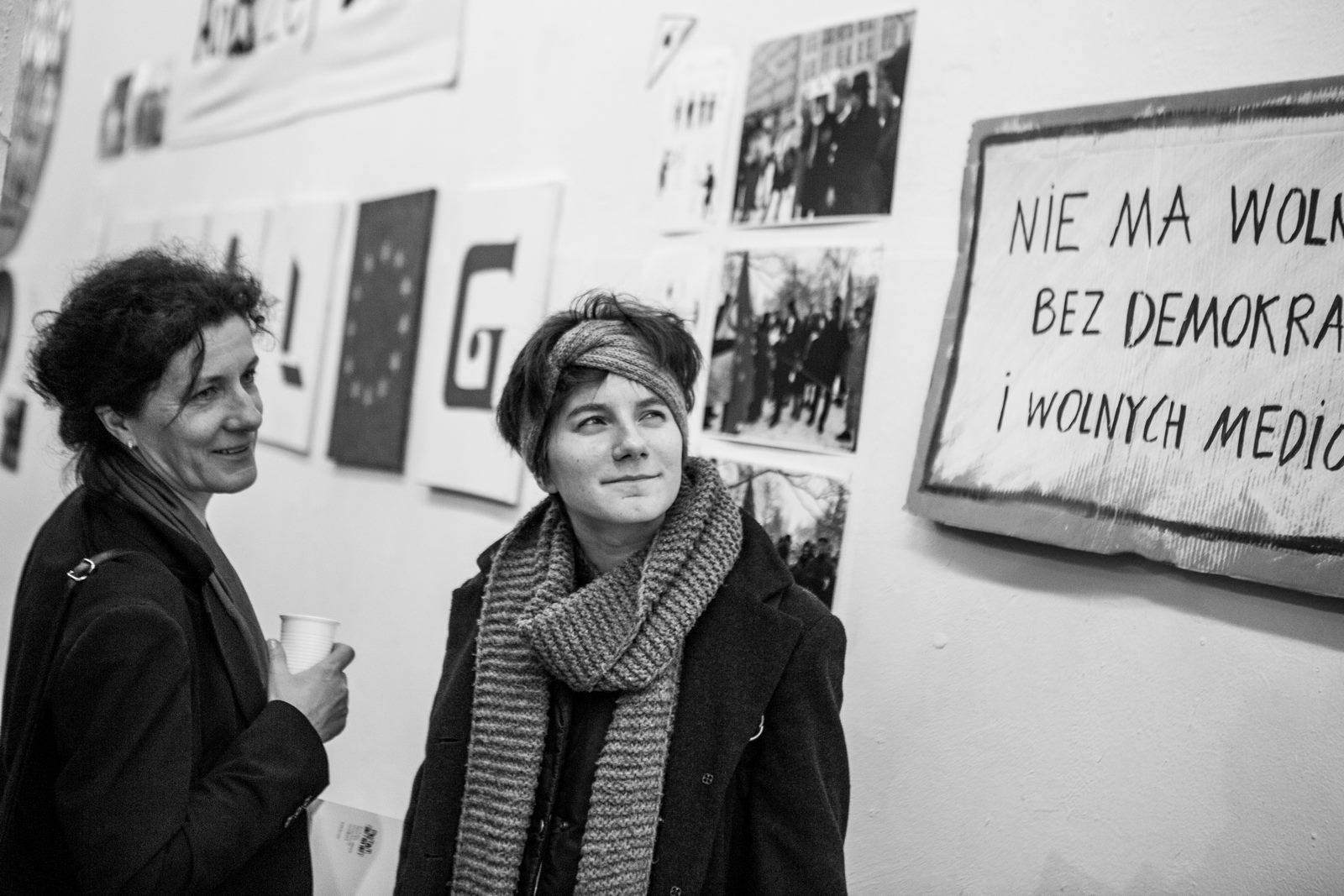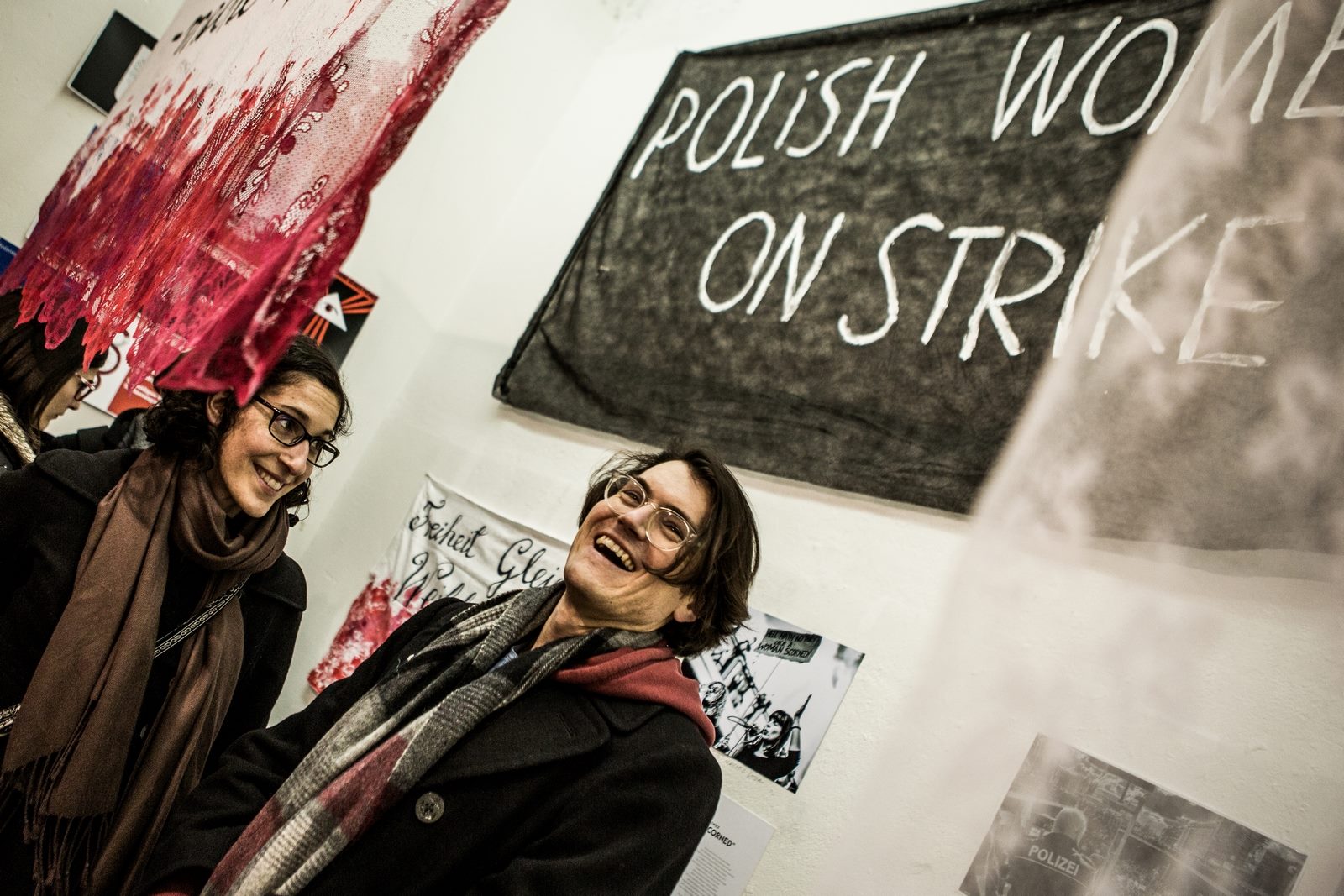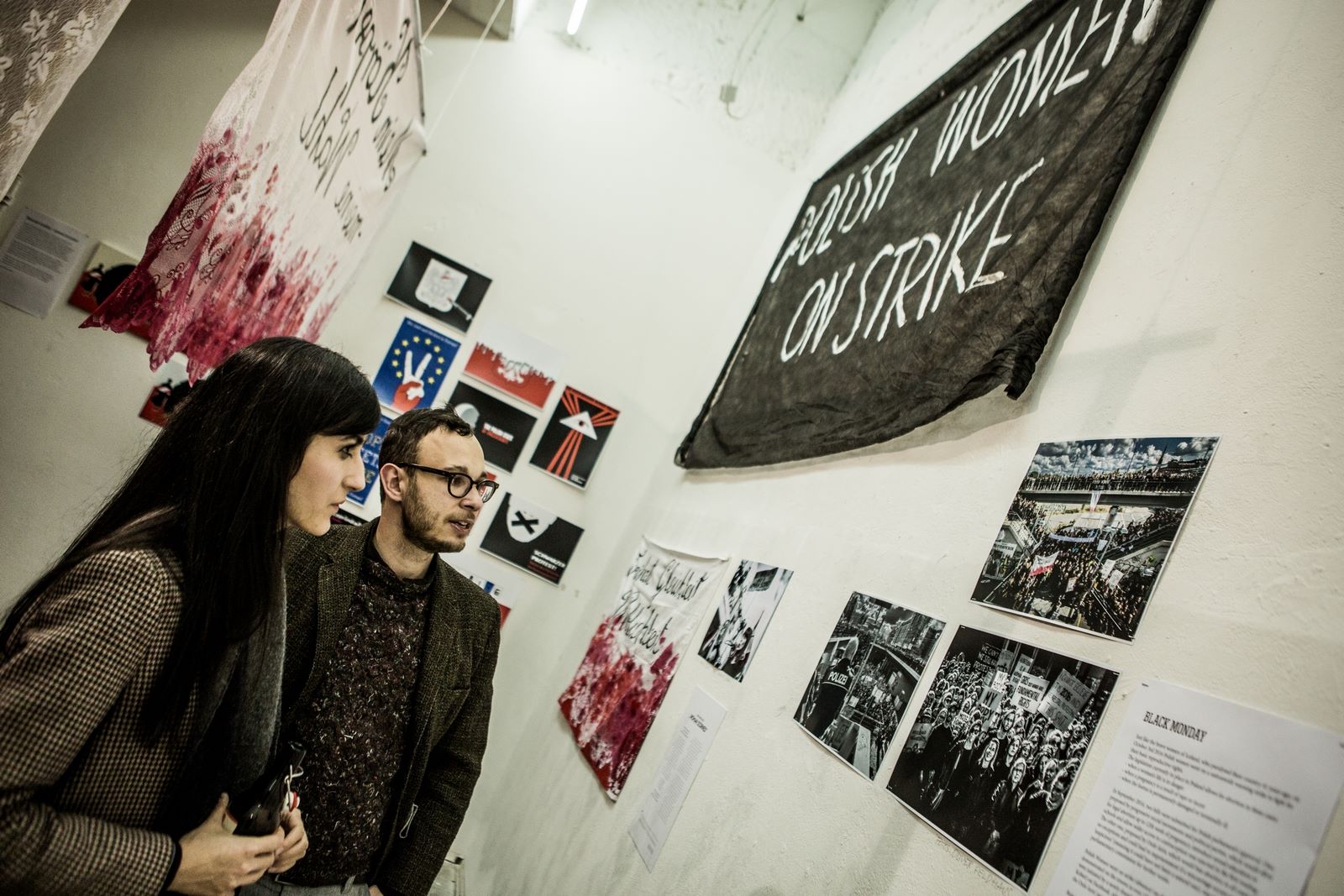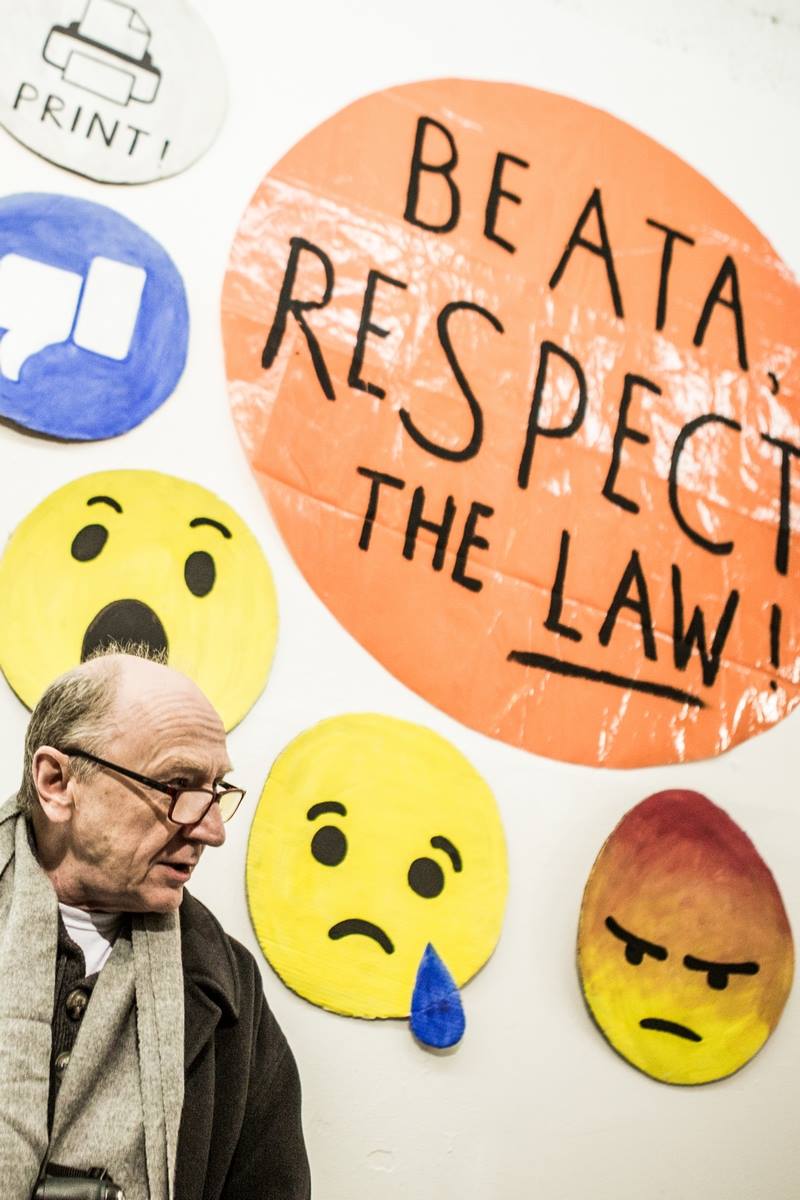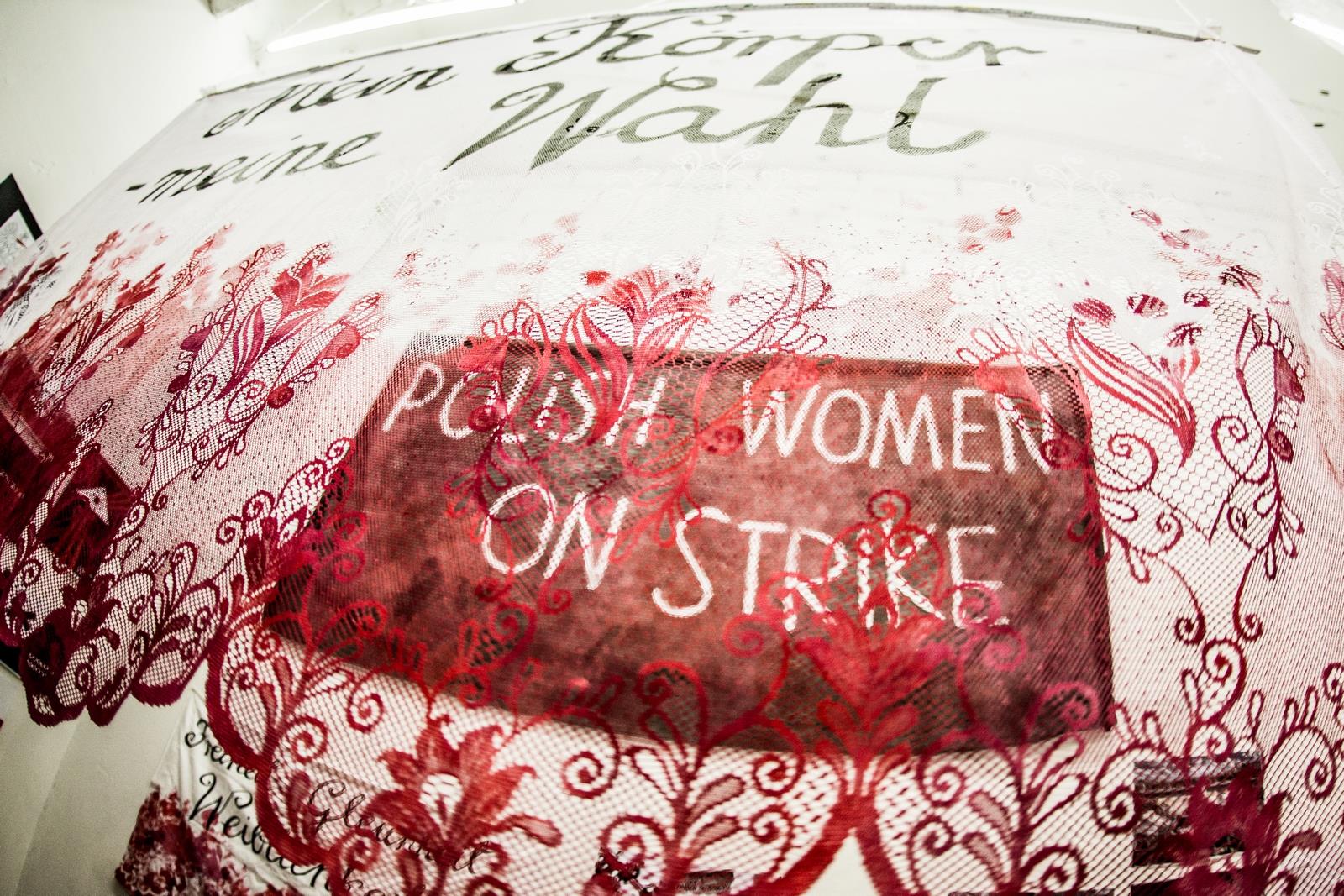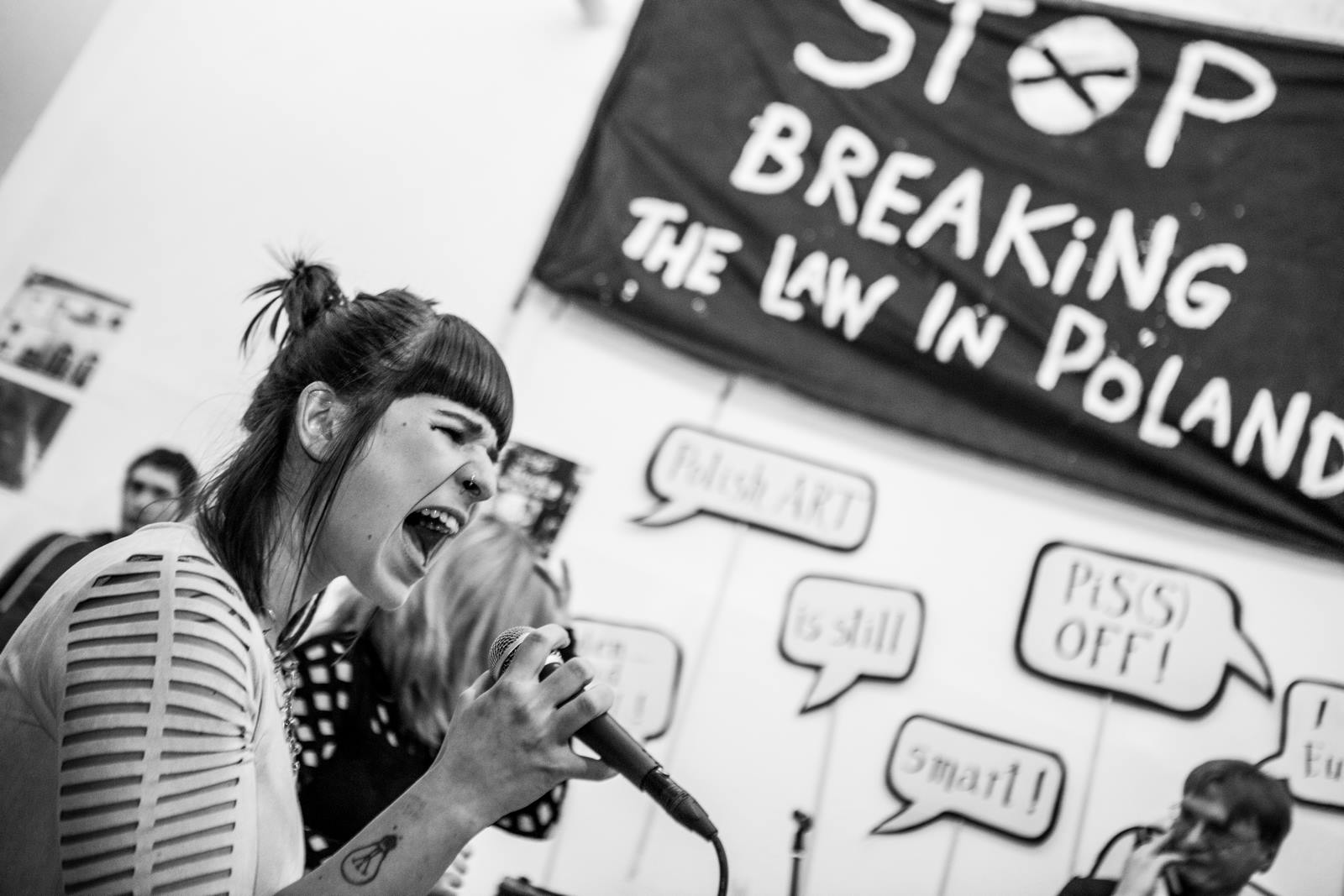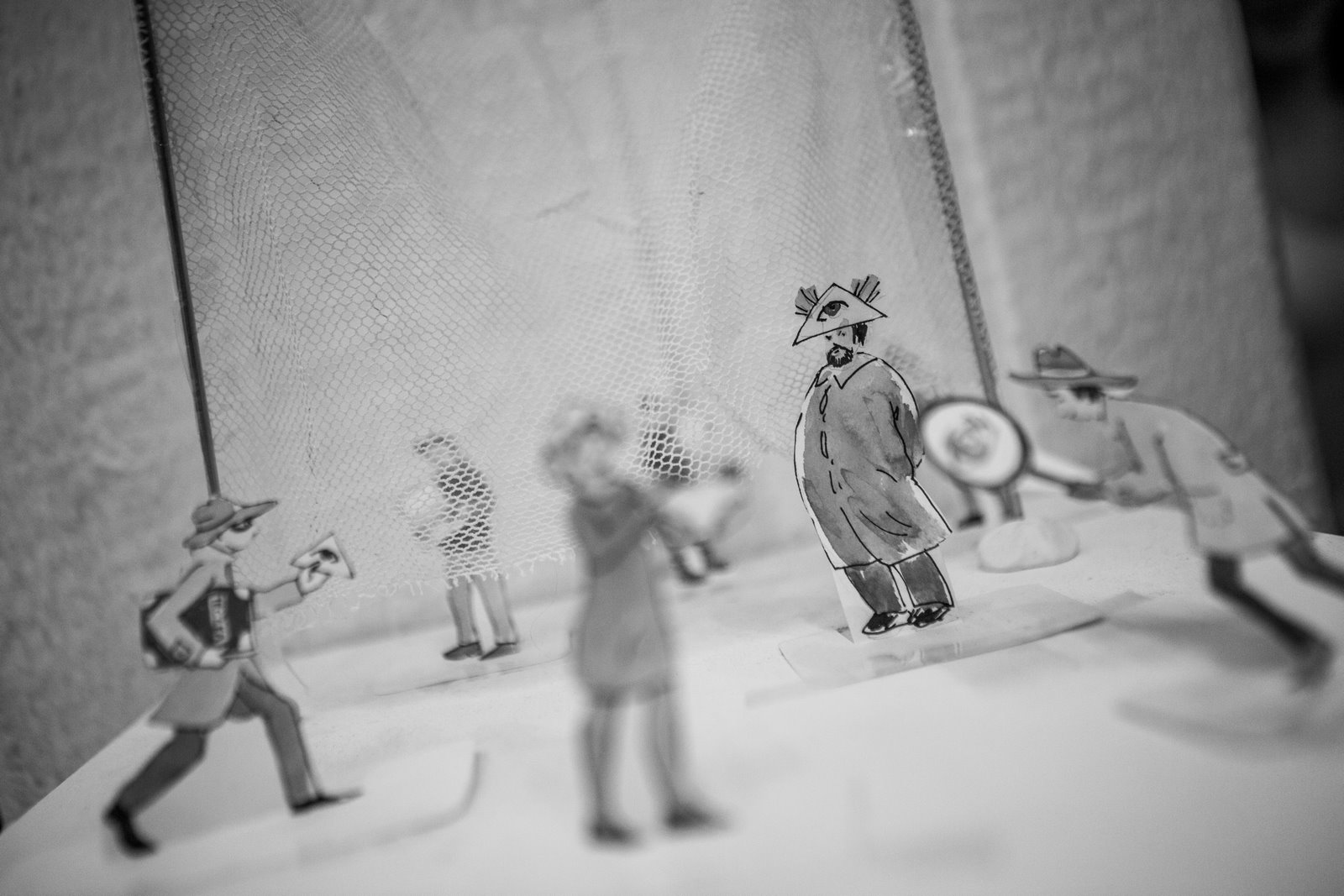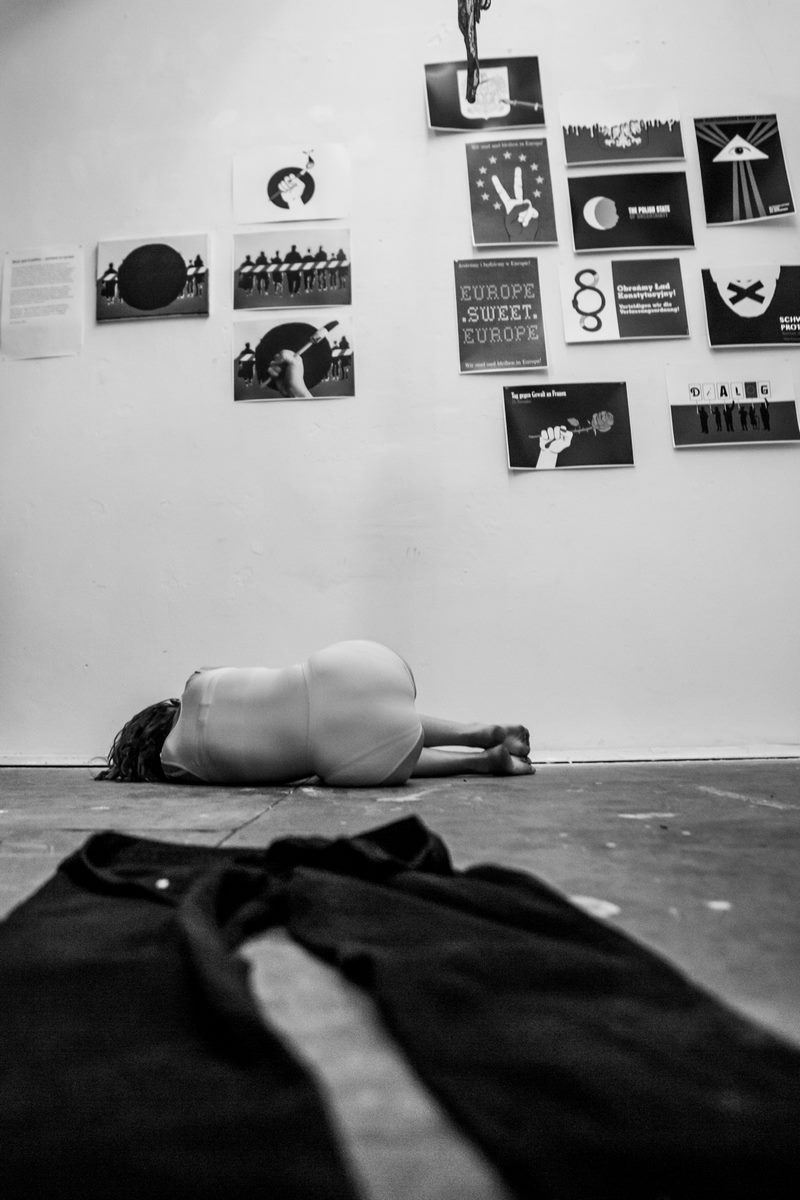Eine Ausstellung von Anna Krenz
feat. Wojtek Drozdek, Oliver Feldhaus, Monika Saczyńska, Maciej Soja, Marian Stefanowski, Michał Zak
Eröffnung: Freitag, 3 Februar 2017 | 19 Uhr
Konzert: Two Times Twice
Performance: Gosia Gajdemska “Ein und…”
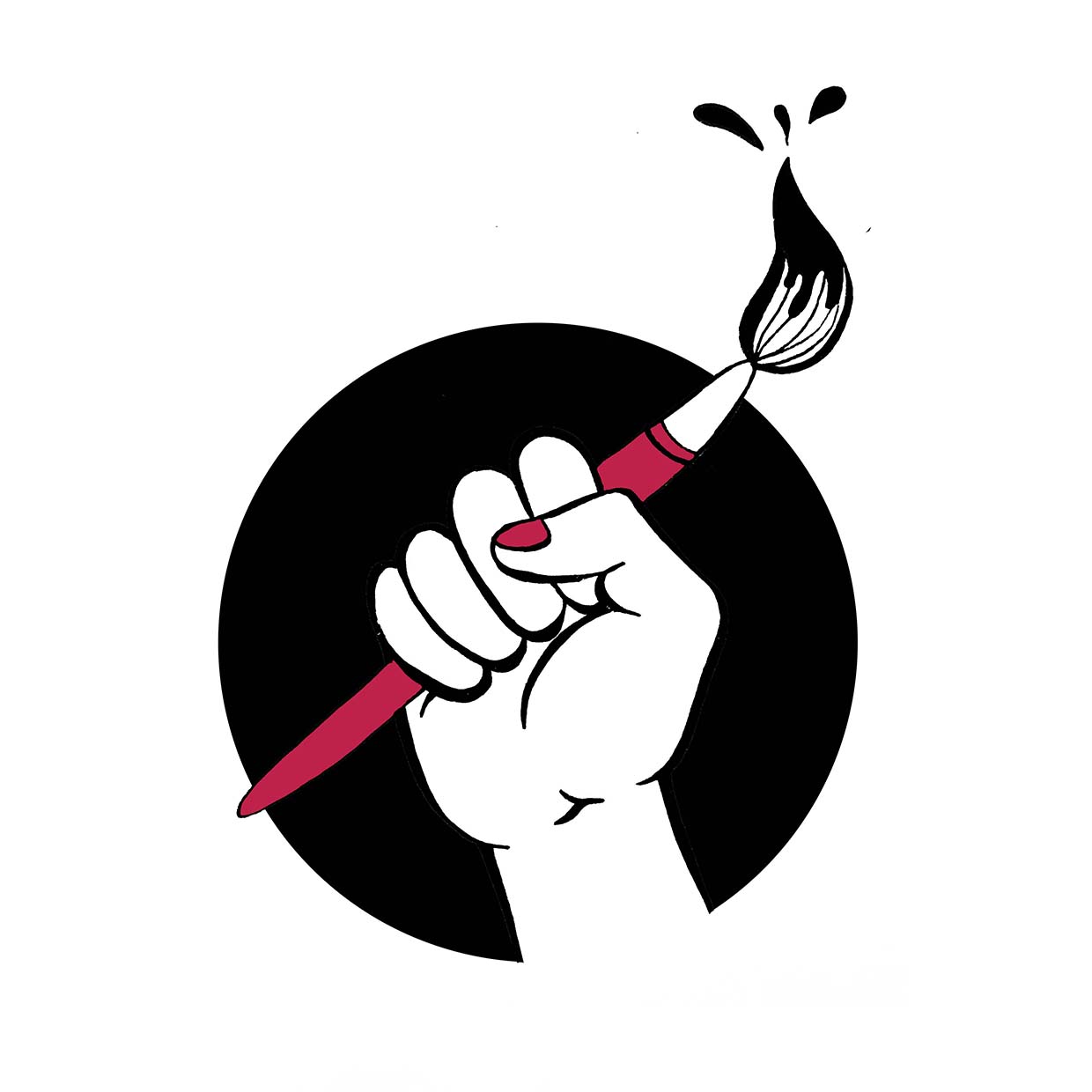
SCHAU FENSTER | Raum für Kunst
Lobeckstr. 30-35 – 10969 Berlin | Kreuzberg
www.dasarty.com
Facebook
(English description below)
Eine Ausstellung von Plakaten und Transparenten von Anna Krenz, die für in Berlin stattgefundene Demonstrationen gegen die rechtskonservative Politik in Polen entstanden sind.
Seit dem Wahlsieg der populistischen PiS-Partei im Dezember 2015 befindet sich Polen auf dem Weg in eine Autokratie. Die Politik der von Jaroslaw Kaczynski kontrollierten Regierung führte zum Zerfall wichtiger Institutionen wie dem Verfassungsgericht, einer Gleichschaltung der Medien und nicht zuletzt einer Spaltung der polnischen Gesellschaft. Von Beginn an protestieren zigtausende Polen gegen diese Entwicklungen, auch in den polnischen Communities außerhalb des Landes. So auch in Berlin.
Anna Krenz hat sich in ihrer künstlerischen Arbeit stets auf politische und soziale Themen bezogen. Oft ironisch und/oder humorvoll. Als Mitglied des Berliner Ablegers der polnischen Bürgerbewegung Komitees zur Verteidigung der Demokratie (KOD) und in der Gruppe Dziewuchy Dziewuchom Berlin (Mädels für Mädels), hat sie seit Januar 2016 Transparente, Plakate und Grafiken für Demonstrationen hergestellt. Für jede Protestaktion wählte sie ein eigenes visuelles Konzept, passend zum Thema, teilweise verwies sie dabei auf ihre früheren Arbeiten, die vorwiegend für den „normalen“ Kunstbetrieb entstanden sind. Sie verwendete die gleichen Werkzeuge und Materialien für die Transparente, die nun von einem anderen Publikum, den Protestierenden auf der Straße, gesehen wurden und nicht wie früher in geschlossenen Ausstellungsräumen. Plakate und Transparente sind in der Regel anonym, was in dem Fall auch eine Herausforderung für den Künstler darstellt. Sie werden zu Objekten der angewandten Kunst, ein Medium, das die Botschaft vermitteln soll ohne eine künstlerische Dimension zu benötigen. Doch die nun ausgestellten Banner und Transparente in der Ausstellung „Tausend und ein Wort“ im Schau Fenster werden durch den Kontext der Galerie wieder zu Kunstobjekten. Dieser Prozess soll ein Ausgangspunkt sein, für eine Diskussion über die Bedeutung von Kunst und angewandter Kunst in ihrem Verhältnis zur Politik und politischen Aktionen.
Neben den Plakaten und Transparenten, sind in der Ausstellung auch dokumentarische Aufnahmen von zahlreichen Protestaktionen zu sehen, fotografiert von Wojtek Drozdek, Oliver Feldhaus, Monika Saczyńska, Maciej Soja, Marian Stefanowski und Michał Zak.
Anna Krenz
geboren 1976 in Posen/Polen, ist Künstlerin und Redakteurin. In ihrer Kunst beschäftigt sich Krenz mit gesellschaftlich-politischen Themen, wie geschlechterspezifischen Rollenmodellen, den deutsch-polnischen Beziehungen, Vorurteilen und Religiosität. Sie arbeitet multimedial in den Bereichen Malerei, Zeichnung, Video, Netart und Performance. Seit 2001 kreative Mitarbeiter des Folkecenters for Renewable Energy, Denmark. Als freie Journalistin kooperiert sie mit den größten polnischen Kultur- und Architekturmagazinen. Sie war Chefredakteurin des polnischen Designmagazins „VOX Design“ und danach von „re:design“. Von 2003 bis 2012 leitete sie gemeinsam mit Jacek Slaski die Galerie ZERO in Berlin. Sie spielte eine rosafarbene E-Gitarre bei der Band The Curators. Lebt und arbeitet seit 2003 in Berlin. www.annakrenz.net
Wojtek Drozdek (1950, Lodz)
Philologe, Verleger, Buchhändler – gründete 1978 erste polnische Buchhandlung in der BRD. Mitbegründer der Arbeitsgruppe Solidarnosc in West-Berlin.
Oliver Feldhaus
Im Ruhrgebiet geboren, im Rheinland aufgewachsen, lebt und arbeitet jetzt in Berlin. 2013 kam er als teilnehmender Beobachter des Kampfes der Refugees für ihre Rechte zur Fotografie. Seither begleitet er als Fotograf neben der Refugeebewegung intensiv viele weitere soziale Bewegungen und Proteste. Seine fotografische Heimat hat er bei den Photographers in Solidarity (http://www.photographers-in-solidarity.org/) und dem traditionsreichen Umbruch Bildarchiv (http://www.umbruch-bildarchiv.de/willkomm1.html) in Berlin Kreuzberg.
Monika Saczyńska
Historikerin, Verasserin zahlreicher wissenschaftlicher Arbeiten zum Thema Religion und Mittelalter. Von Beginn an engagiert in der KOD-Gruppe Berlin. Amateurfotografin. Sie lebt und arbeitet in Berlin und Warschau.
Maciej Soja
Freiberuflicher Fotograf, Veganer, verbunden mit Bewegungen für Menschenrechte. Tierschutzaktivist. Aktivist bei Basta. www.facebook.com/fotosoja/
Marian Stefanowski
Lebte bis 1981 in Torun, seit dem in West-Berlin. Pressefotograf, seit 1988 Mitarbeiter im Arsenal (Institut für Film und Videokunst). Mitbegründer der Arbeitsgruppe Solidarnosc in West-Berlin.
Michał Żak
Fotograf und Grafikdesigner. Er absolvierte ein MA in Philosophie an der Adam Mickiewicz Universität in Poznań. Laut Lürzer-Archiv gehört er zu den „200 besten digitalen Künstlern weltweit“. www.michalzak.net
Two Times Twice
Ein musikalisches Duo, das Ende 2015 in Berlin gegründet wurde. Zwei Künstlerinnen, Edyta und Sarah, bezaubern mit ihren einzigartigen Stimmen und Klängen, die unterschiedliche Musikstile in einem dynamischen und lebendigen Kunststück verbinden. Two Times Twice ist eine Beziehung. Eine musikalische Beziehung. Edyta, geborene Sängerin und Polin, hat ihre Liebe zur Klassischen Musik durch eine Musikausbildung schon als Kind entwickelt. Sarah kommt aus London, wo sie in 2012 die große Bühne des UK-Rap-Battles auftrat. Ihre Texte sind gleichzeitig poetisch und ehrlich. Zusammen komponieren Edyta und Sarah eine Musik, die aus ihren eigenen Geschichten und vielen eklektischen Hintergründen entsteht. soundcloud.com/twoxtwice
Gosia Gajdemska
Choreographin,Tänzerin, Performerin, Tanzpädagogin.
Direktorin diverser Tanz- und Theaterprojekte und sozial/politisch engagierten Kunstprojekte (mit Profis, Kindern, Jugendlichen, Immigranten, blinden und tauben Menschen). In ihren Arbeiten verbindet sie verschiedene Tanztechniken mit somatischen Praktiken und bildender Kunst. Jetzt arbeitet sie vor allem mit dem Thema Choreographie als visuelle Kunstform.
The exhibition “Thousand and One Word” features banners and graphics of Anna Krenz, made for various demonstrations against the conservative nationalist Polish government that took place in Berlin.
Since the end of 2015, as the conservative right wing Law and Justice party (Prawo i Sprawiedliwość, PiS) became the majority in the polish government, things took a serious turn. PiS leads Poland towards dictatorship, paralysing the Constitutional Tribunal, dismantling free media, trying to ban abortion, promoting nationalism and hate speech, destroying polish economy, ignoring the European Commission, or distancing Poland from the EU, etc. Polish society is divided according to political views. Public media became national/ist and presented reality is manipulated for the sake of the government. Many people lost their jobs due to political views. As a reaction, thousands of polish people formed grassroots movements and went out to the streets to protest and demonstrate against actions of the government, both in Poland and abroad – also in Berlin. Situation is getting more and more serious, however this is not a Polish-only phenomenon. Conservative right-wing politicians become more and more popular around the world.
Anna Krenz has always been working with political and social subjects in her art., often with irony and humour. As member of polish Committee for the Defense of Democracy (KOD) and Dziewuchy Dziewuchom in Berlin, since January 2016, Anna Krenz had been creating transparents and graphics for actions and demonstrations, each has a different visual concept according to a theme-specific idea, some were directly inspired by her previous art works. Using same tools and media, as used for making art exhibited in galleries in previous years, Krenz painted transparents, which are seen by bigger masses on the streets, instead of white cube gallery spaces. Banners are anonymous – a challenging experience for an artist. They were objects of applied art, a pure medium for sending a message without the art world context. Art served an idea, served people, it became a political statement itself. Exhbited banners at Schau Fenster become art objects again. This process is a starting point for a discussion about the meaning of art and applied art in our contemporary political world.
Next to the banners and posters, there are photos documenting various demonstrations and actions, taken by activists and/or photographers: Wojtek Drozdek, Oliver Feldhaus, Monika Saczyńska, Maciej Soja, Marian Stefanowski and Michał Zak.
Black spot of politics – personal art protest
I painted „Schwarzarbeit” in 2003, on the verge of Poland’s entry to European Union. Many Europeans, mostly Germans, were uncomfortable with the idea of a flood of polish economic immigrants searching for work. However, nothing happened. Polish people were already working in Germany, and those who came, melted quietly into the job market. In 2016, the same painting shows a different situation, a glimpse from the other side. Now the Polish people and the government are afraid of the flood of refugees from war countries.I chose this particular painting and made a point on it. „A black spot on the painting” is an expression of my protest against current political situation in Poland, against radical actions of the polish government, social divisions and political fanatism, against hate language and limitations of artistic freedom. This blind spot of polish politics has to go! Point! A black spot!
Over 100 years ago, Kazimir Malevich panited his world famous „Black square” – the so-called “zero point of painting”, an abstract representation. The black spot on „Schwarzarbeit“ changes the painting into a zero point of what it was. Now – it is a protest.
Anna Krenz, 2016
Free Media – DEMO
On December 30, 2015, the Law on Radiobroadcast and Television was amended, with provisions designed to expire on June 30, 2016. The amended legislation („small media law“) allows the government to choose new heads of government television and radio stations, and to exert further control over board members and managers of media outlets. Many journalists and managers, with years of service behind them, have lost their jobs since the takeover – in the public TV stations alone, 45 journalists and broadcasters have been dismissed and many more have resigned in protest. This move is partly dictated by plans to reshape Polish public media to promote traditional, national and Christian values, and to continue to implement the government’s vision of media as a vehicle for communicating the government’s agenda.
All transparents for “Free Media” were made with rough strokes of brush, in contrast to new media aesthetics. Banner „Kaczyński na księżyc, ale na jego ciemną stronę“ (Kaczyński to the Moon, but to its dark side) refers to the movie “O dwóch takich, co ukradli księżyc” (The Two Who Stole the Moon), in which both Kaczyński twin brothers played as children. Carrot on the bicycle depicts words of Foreign Minister Witold Waszczykowski, who in interview with German tabloid “Bild” (January 2016) took issue with the critical reaction of foreign media to PiS’ recent election wins, claiming the Polish Government just want to “heal certain diseases” in the country: “The previous government implemented a left-wing concept, as if the world had to move using a Marxist model in only one direction: towards a mixture of cultures and races, a world of cyclists and vegetarians, who only use renewable energy sources and combat all forms of religion. This has nothing in common with traditional Polish values. This is against what most Poles have at heart: tradition, historical consciousness, love of the country, faith in God and a normal family life run by a man and a woman.”
9. January 2016 – KOD demonstration „Free Media“ in Berlin with guests: Ronald Jahn (Bundesbeauftragter für die Stasi-Unterlagen), Bernd Lammel (DJV), dr Michael Rediske (Reporter ohne Grenzen), Karl Forster (“Polen und Wir”; Deutsch-Polnische Gesellschaft der Bundesrepublik Deutschland), Jacek Tyblewski (Rundfunk Berlin-Brandenburg), Christine Ziegler (Regebogenfabrik).
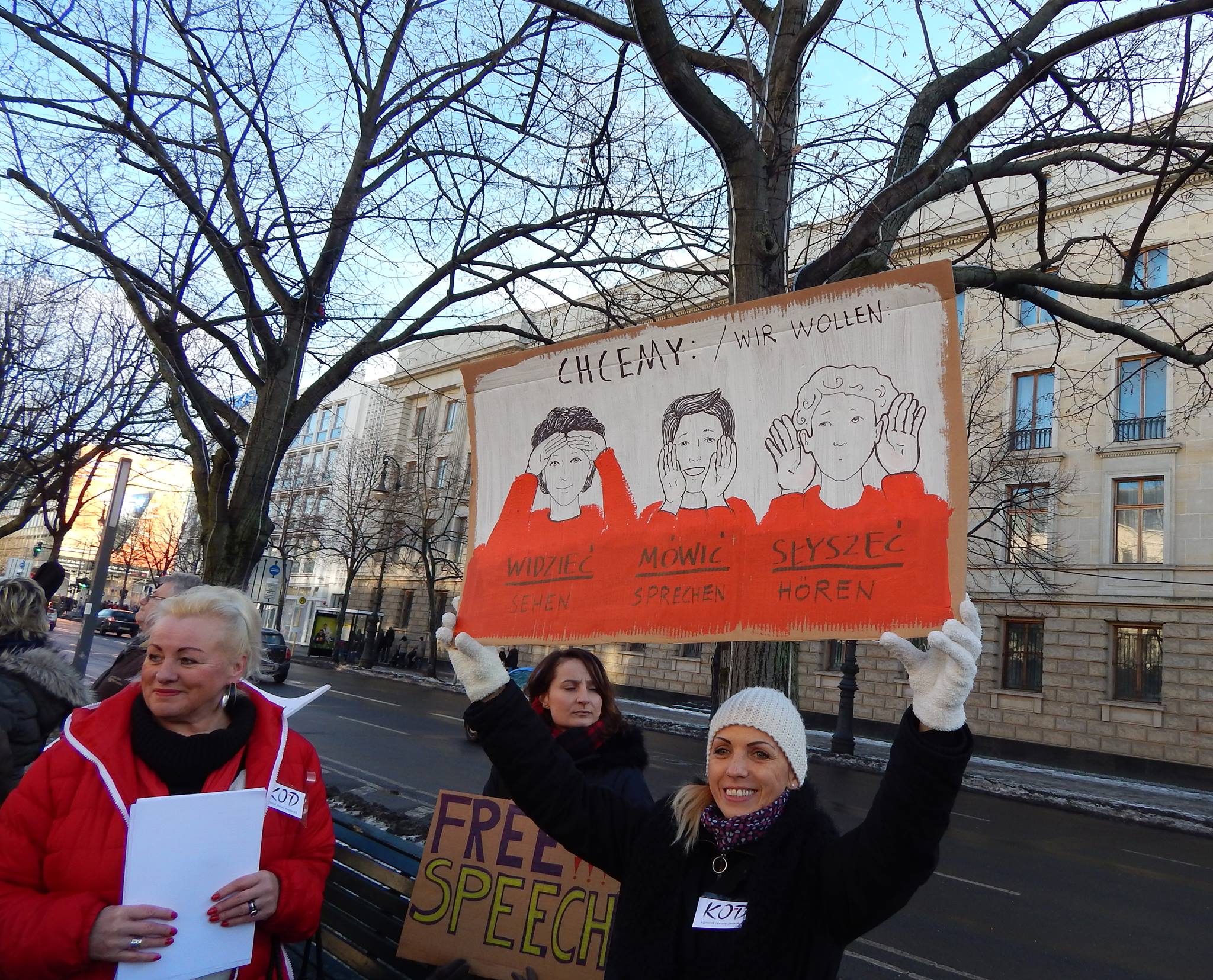
The Chairman’s EYE – Happening
In January 2016, Poland’s government was planning legal changes (New Surveillance Law) that would increase the surveillance over the country’s citizens. The new provisions, proposed by the ruling Law and Justice Party, would increase the government’s access to digital data while reducing restrictions on the use of surveillance by the police. Poles have actively protested the new surveillance rules, and the opponents of the plan argue that the changes will harm privacy rights, suggesting that under the proposal “privacy, intimacy is under threat, people can be followed, watched over both in homes, and online.” The Polish government’s move has also alarmed the EU, which has started investigating charges that Warsaw is undermining the EU democratic principles. On 3 February 2016, the Polish President, Andrzej Duda, approved the legislation on mass surveillance.
„Not so far away, behind forests and a river, there lives a Chairman. He rules a big country, even though he was not the king. Thou, the king has other matters to deal with. The king is signing, writing and addressing. The Chairman is then governing the country with an iron hand, do not let the smile fool you, behind the mask there is a cold face of a pragmatic. The Chairman is the man of steel, well, of coal.
The Chairman loves his folk, sure, but not all of them – he loves 38% of the nation (with return), which he sees as superior. He despises 19% of people and he would not care less for the rest.
And then, one day, the Chairman fell he would like to get to know his people better, a lot better. Who are these citizens, with whom do they talk, what do they buy, which websites do they visit, how much savings do they have… all that is interesting for the Chairman. HE simply wants to know more, because he loves his folk… (…)”
Anna Krenz, 2016
Instead of a classic demonstration, KOD Berlin organised a political street happening in front of the Polish Institute in Berlin. „The Chairman’s Eye“ (idea, screenplay and direction: Anna Krenz) gathered a large audience which actively participated in the happening. The story was about a Chairman (symbol: all-seeing eye), who surpressed his people (symbol: red rope), watched them like big/twin brother (symbol: magnifying glass), collected data about private matters (red folder). The curtain is covering but also unveils private matters of the people. The citizens (audience) were tied by the Chairman’s agents with a red rope, however, they were given hope, motivation, strenght and scissors and they freed themselves from Chairman’s bondage and slavery. Power to the people!
23. January 2016 – political happening „The Chairman’s Eye“, prepared and realised by KOD Berlin.
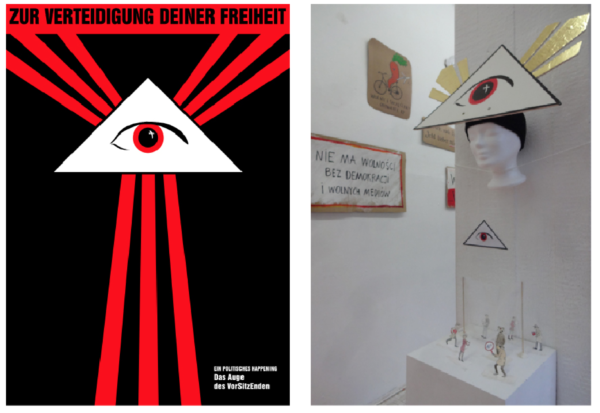
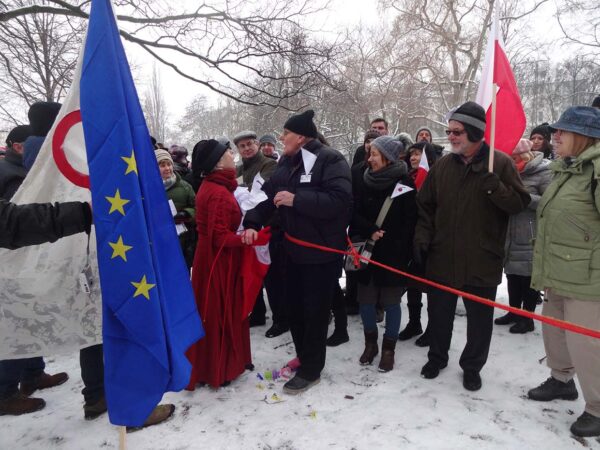
DIALOG with Beata Szydło
Polish Prime Minister Beata Szydło has met Chancellor Angela Merkel in Berlin. The German government has invited Szydło three times, but she waited almost 100 days before accepting. Since taking office in November, Szydło has already visited six states, including Hungary. Differences were apparent as Szydło and Merkel met on Friday, with Europe’s refugee and migration crisis perhaps proving most divisive. While Szydło said Poland would play a role in the EU-wide redistribution of 160,000 people, she ruled out the concept of permanent migrant quotas.
Since PiS took over the polish government, relations between the two countries have been cold. Lack of communication, accusations and different political views have put weight on the visit. Merkel and Szydło may not become best friends.
During the visit Beata Szydło was invited by Körber-Stiftung and held a speech at the Humboldt Carré. KOD Berlin welcomed Prime Minister at the gates with a call for a DIALOGUE. A dialogue with German government but also with Polish citizens (in Poland and in Berlin). Being concerned about Premier Szydło’s actions and political decisions, concerning Constitutional Court crisis, public media and invigilation, we called upon an honest and open dialogue about the situation in Poland, solidarity with the EU and good relations with Germany, Poland’s most important neighbour.
DIALOG with Beata Szydło is a visual representation of the call, 6 letters, each in different font, on a different canvas, symbolise different foreign languages, difficulties in communication resembling Tower of Babel. The letters, however, may be put together to form a sensible word, understandable message and entity to show that there is hope and a call for understanding.
12 February 2016 – Prime Minister Szydło’s visit to Berlin.
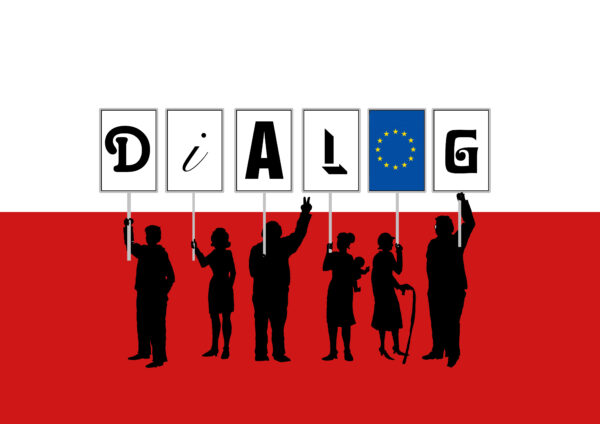
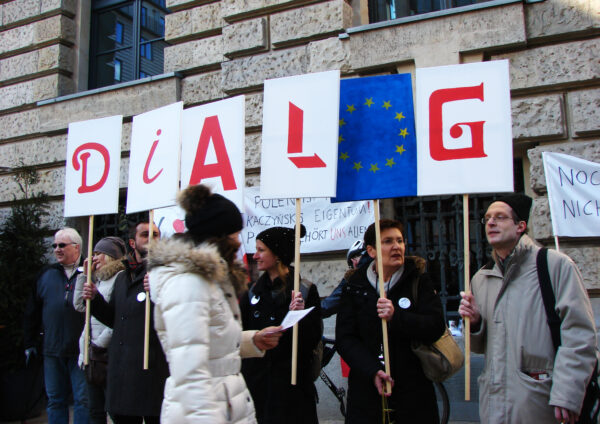
HANDS OFF / my underskirt
Spring 2016 was marked by demonstrations against plans of the polish government to introduce total abortion ban in Poland. Spring, windows open after a long winter, fresh air and sunlight come in and provide us with energy and strenght to fight for our rights.
As a private protest I hanged a lace curtain in my window. Lace is a female element, petticoat-like, intimate and private. It covers our private parts, but it also unveils – lets the sunlight in. Part of the curtain is painted in red, resembling the polish flag and symbolysing love, life, blood and revolution. The curtain had been used on various demonstrations and actions in Berlin.
I already worked with lace as part of an art installation, which is a direct inspiration for that banner. In projects like „Polish Wife“ or „The Unbearable Lightness of Beauty“ (exhibited in Legnica, “Sweet in Art”) lace was a crucial element. “Polish Wife” was a project against material approach to Polish women, where I was ironically selling Polish women, as wives. Some people actually believed that and ordered a “wife”. In „The Unbearable Lightness of Beauty“ I explored relations between pleasure, beauty, expectations and pain.
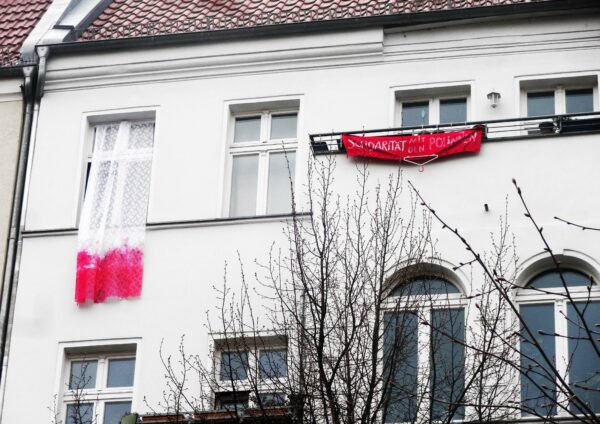
WELCOME, ANDRZEJ DADA!
On Thursday, June 16th, we have welcomed the Polish pRESIDENT Andrzej Duda, who travelled with his wife to an official meeting with President Gauck in Berlin. Wearing funny and colorful hats, we have gathered in front of the Bellevue Palace and greeted the delegation with a dadaist banner „Welcome! pRESIDENT Andrzej DADA“.
Once, the polish President said that he is „the president of all Polish people“, however, as his actions and recent events in Poland show – he is not the president of all Polish people. He seems to be dependent on others, on his party, he cannot or he would not fight for his own independent opinion, well, maybe he has none. Therefore, maybe Andrzej Duda is not the President of Poland? Maybe it is someone else?
Current political situation in Poland is becoming more and more rough and tense, more and more abstract… dadaist. Some of the people start to think it is all not real. The Government’s actions followed by controversial laws and acts, hate speech drippng off media and politicians’ mouth and deep division of the polish society are causing increased negative emotions among people. We react by going out to the streets, protesting against such development. Maybe taming of this grim reality by humor and disenchanting the bad by irony can help us all not to fall into madness.
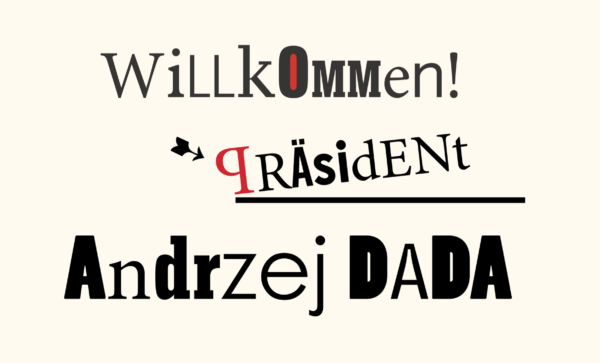
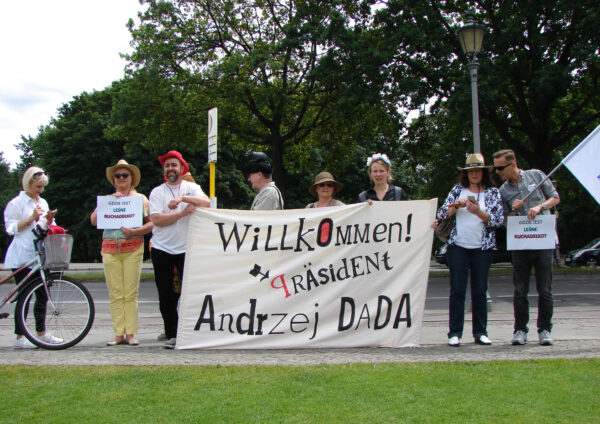
BEATA, RESPECT THE LAW
The polish premier minister Beata Szydło visited Berlin on 22 June 2016. It had been the 105 days since the government did not accept and did not published the judgement of the Constitutional Court (from 9 March) about the amendment law (from 22 December 2015) that limits competences of the Constitutional Tribunal.
Beata Szydło met Angela Merkel and members of the German government to discuss future and present politics and common relations between the two countries.
The meeting took place during the day, so it was not possible to call for a big demonstration, only a small group of KOD Berlin members came at that time. I decided to make visually strong transparents, that send a direct message to Beata Szydło. Due to a distant location of our gathering to the Kanzleramt, the banners had to have bright colors and simple shapes.
Enlarged Facebook icons with negative emotions expressing anger, sadness, surprise and disklike transported a clear message – we do not accept and we do not like actions of the Polish government.
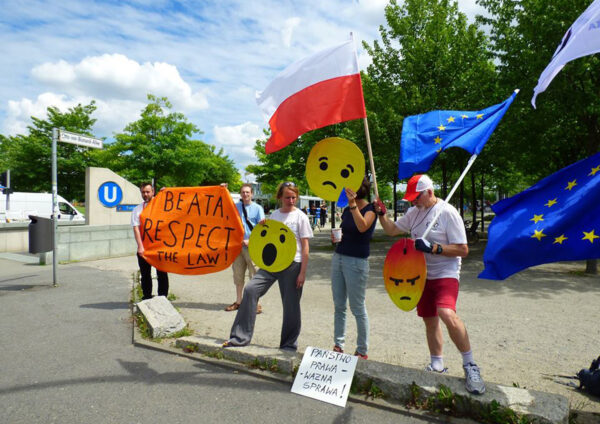
BLACK PROTEST
Since the takeover of power, the Polish government has been pursuing a reckless but consistent policy of disempowerment of the Constitutional Court – only institution that can determine whether there has been a violation of fundamental right. The government tried repeatedly – through Parliament’s legislative initiatives – to amend the laws on the Constitutional Court within the line of PiS’s strategy.
In June 2016, parliamentary consideration began on bills on the Constitutional Tribunal submitted by the ruling party, a bill offered by other MPs, and the proposal from civil society (KOD). In the end, however, the Sejm worked only on the bill that was presented by the ruling majority. The new bill on the Constitutional Tribunal introduced several regulations that can lead to a paralysis of the court’s functioning.
The most controversial provision was introduction of the so-called blocking mechanism: during a full bench debate, four judges may veto the ruling proposition, which would lead to a three-month adjournment. The veto may be repeated once more. There were also regulations saying that in cases of ruling in full bench, the case must be adjourned if the properly informed prosecutor general is not present. Under the bill, all judges that were chosen by the Sejm and sworn in by the president must immediately begin doing their duties (like judges sworn by President Duda in December 2015, to seats that were already occupied. The decision about publishing of the verdicts is to be taken by the prime minister based on a request lodged by the president of the Constitutional Tribunal. The bill, passed on July 30, was the third amendment since November 2015, following the Law and Justice party’s rise to power.
In many Polish cities KOD organised demonstrations against the proposed bill called Black Protests. KOD Berlin demonstrated solidarity with Black Protests taking place in Poland at the same time, following KOD’s call to demonstrate dressed in black, stand in silence with taped mouth. After a ten-minute silence, accompanied by regular sound of a bell, we tore the tape from our mouths and claimed our postulates directed to the Polish government, asking to stop paralysing the Constitutional Tribunal.
The banner I made for the Black Protest was simple – black background with painted white letters with clear violent gestures, to emphasise anger that constrasted with the silent and still presence of protesters taking part in the black protest. The same transparent was later used on few other demonstrations.
5 July 2016 – Black Protest, organised by KOD Berlin.
BLACK MONDAY
Just like the brave women of Iceland, who paralysed their country 41 years ago, on October 3rd 2016 Polish women went on a nationwide warning strike to fight for their basic reproductive rights.
The legislation currently in place in Poland allows for abortion in three cases:
– when a woman’s life is in danger
– when a pregnancy is a result of rape or incest
– when the foetus is permanently damaged or terminally ill.
In September 2016, two bills were submitted for Polish parliament’s approval. One, proposed by progressive social movements and political parties, which would allow for legal abortion up to 12th week of pregnancy, introduce sexual education in schools and allow wider access to contraception was rejected in the first reading. The other one, proposed by Ordo Iuris, which would ban abortion in all cases with no exceptions and could lead to imprisonment if a miscarriage occurs and seems ‘suspicious’ (meaning it could have not been a natural one), was passed along to a parliamentary commission for further works.
Polish Women went on strike (absence/ on-demand leave/ day off) and demonstrated on the streets in over 130 cities in Poland and 30 countries. Protests and strike were initiated by different activists, Dziewuchy groups and regular women. The Polish Women’s Strike (Ogólnopolski Strajk Kobiet) as an event became later a registered organisation. After further protests the Polish government backed off from the Ordo Iuris’ proposal.
Being member of Dziewuchy Berlin, a group of volunteers, I was co-organising the Black Monday – demonstration on the Warschauer Brücke, with invited guests like Margarete Stokowski, Magdalena Ziomek (AgitPolska), Anna Maria Patané (KOD Berlin), Derv Bärlin (Berlin Ireland Pro Choice Solidarity), Ciocia Basia, Joanna Bronowicka (RAZEM Berlin); concert: Two Times Twice.
Transparents used at the theatrical staircase of the Warschauer Brücke were prepared for the demonstration in April 2016. One banner is made of lace, second of a douvet, colored with red paint symbolysing the Polish flag. „Freedom, Equity and Feminity“ are the new qualitites of Poland to come.
3 October 2016 – Black Monday demonstration at the Warschauer Brücke, organised by Dziewuchy Berlin
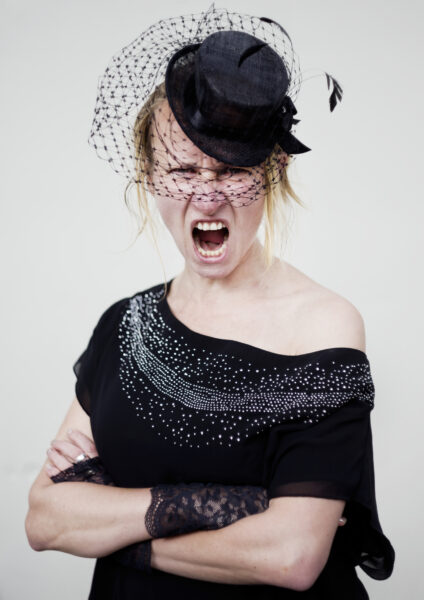
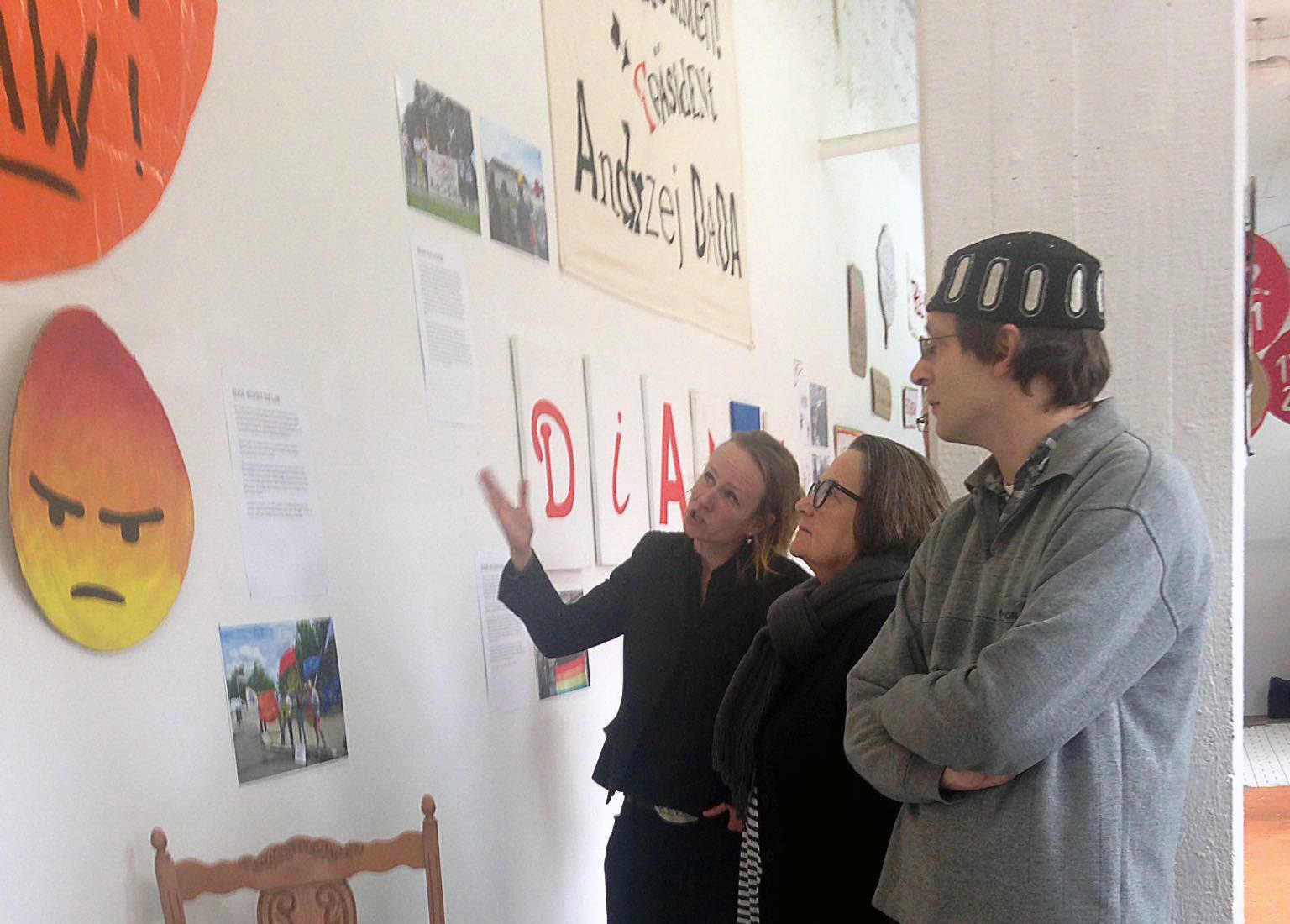
Schau Fenster | Vernissage
Laufzeit: 3.02. – 19.02.2017
Photos by Maciej Soja / Soja Photography
